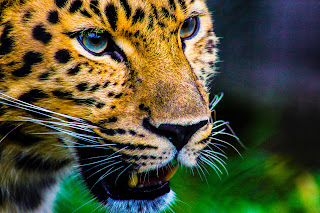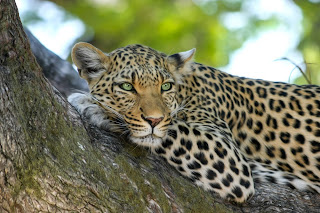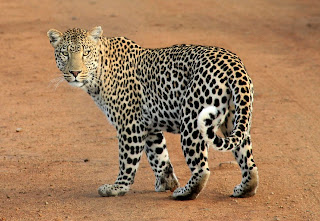Leopards are beautiful and fascinating creatures, but many people don’t know much about them. Some of the information that’s out there on leopards may be incomplete or inaccurate, so we’ve put together this list of 10 amazing facts you may not have known about leopards!
1) The leopard is the smallest of the 4 big cats
The leopard is one of four species in Pantheridae, which also includes lions, tigers, and jaguars. It is also one of 3 members of Carnivora—the family that includes dogs, bears, and weasels—along with all other meat-eating mammals. (The other two are dogs and cats.) That makes leopards carnivores.

2) They are nocturnal
While most people think of big cats, like lions and tigers, as being nocturnal, leopards prefer to hunt at night. They are also territorial: Leopard territories can be up to 37 square miles (about 100 sq km). It’s more difficult for predators to sneak up on their prey if they have a big space with lots of trees to climb. Their fur isn’t just spotted: Leopard spots don’t appear until they are about two months old. Until then, baby leopards are covered in plain brown fur. Their tails play an important role: The leopard's tail helps balance them as they move through trees from branch to branch. It is an excellent counterweight in fighting or climbing. And it has a super long end!
3) Leopards can be found in Africa, Asia, and parts of Europe
There are more than 1,000 different species of leopard. The largest populations live in Africa and Asia, where there are an estimated 12,000 to 15,000 leopards each. Smaller populations live in parts of Europe and about 100 to 200 leopards can be found throughout Central Asia. South Africa has one of the highest concentrations of leopards.
4) Both male and female leopards mark their territory with urine and scat
Male leopards leave their scent on trees, rocks, and other objects. Female leopards mark their territory with urine. The female leaves her scent by urinating or defecating. Leopard scat is relatively easy to identify: If you find fresh droppings that are oblong, it's likely a leopard's—the animals' stool tends to be long, thin, and tapered at both ends. Leopard poop typically looks like a series of small black beads: Although a smaller animal can leave droppings that look like those of a leopard—as some squirrels do—leopard poop looks very different from dog or cat feces.
5) Like all cats, they have excellent hearing
While you probably won’t be surprised to learn that leopards have exceptional hearing, it’s important to know just how well they can hear. Leopards have been recorded being able to detect a sound from as far away as 4 miles—that’s almost twice as far away as most other species of cats can hear! To give you an idea of how incredible that is, consider that some dogs only record being able to hear from about one mile away. This allows them to hone in on their prey while they’re still hidden in tall grass or bushes. If your housecat could do that, he would be quite upset with you for forgetting his dinner so many times each day...

6) Lions roar, but so do leopards
Both lions and leopards are in the same family, Felidae. Although they’re both cats, their vocalizations differ slightly. Lions roar, while leopards have a scream similar to that of a house cat. Lions also tend to be much larger than leopards; they can grow up to 250 pounds, while leopards max out at 120 pounds.
7) They can swim well if need be
While leopards may be best known for their fierce hunting skills on land, they can also swim if they need to! They are great swimmers, able to go as far out as 200 yards (183 m) into a lake and stay underwater for up to five minutes. But don’t be mistaken – it’s not because they have gills; rather, leopards swim with their front legs in a kind of dog paddle, holding their hindquarters up out of water. If you think about it, that’s probably how most people swim – whether you realize it or not! Yet another way in which we share traits with our animal counterparts. Who knew there were so many ways we are like our fellow mammals?
8) Their gestation period is between 90–100 days
The gestation period of a leopard is typically around 90 to 100 days. This means that once a leopard becomes pregnant, she has about 7 months until her cubs are born. (You can read more about pregnancy in wild animals here.) However, they can give birth at any time during that period, with some mothers giving birth only three weeks after mating while others take almost three months to do so. Their claws are retractable: Like cats and dogs, leopards have retractable claws that they don’t have to bother with when they walk on soft surfaces like grass or dirt because their claws won’t dig into those types of surfaces.
9) Leopard cubs weigh about 1.5 pounds at birth
One of the leopard’s most charming traits is that they are adorable cubs. A leopard’s babies weigh about 1.5 pounds at birth and can fit into a teacup when they’re first born. As if that weren’t cute enough, their fur is light cream or white! Leopard cubs stay with their mothers for up to two years before striking out on their own.
The spots on a leopard’s coat protect it from predators: The dark spots on a leopard’s coat help protect it from predators like lions, tigers, hyenas, and other animals who would love to make a meal out of them. The darker areas blend in with shadows so that predators have trouble seeing them in tall grasses or bushes—and even if they do see them moving around, it looks like just another part of the landscape instead of an animal trying to hide. It also helps protect them from getting too hot during warm weather because those dark spots absorb heat better than lighter colored areas do.

10) Compared to other big cats, they live quite long in captivity (more than 20 years).
Compared to other big cats, they live quite long in captivity (more than 20 years). They are also known as The Ghost of Africa and can run up to 68km/h. The name Leopard was given to them due to their spotted pattern which resembles that of a leopard. Also, Male leopards have larger roars than females.: Male leopards have larger roars than females. Their roar can be heard up to 9km away. A cub stays with its mother for about 2 years before going off on its own.: A cub stays with its mother for about 2 years before going off on its own. The largest litter size is 5 but has been recorded at 7. They spend most of their time alone or in pairs.: They spend most of their time alone or in pairs. Leopard facts: The African Leopard is one of four 'big cats' found on our continent - lions, leopards, cheetahs, and tigers being the others.: Leopard facts: The African Leopard is one of four 'big cats' found on our continent - lions, leopards, cheetahs, and tigers being the others. It lives mainly in sub-Saharan Africa although it may occasionally stray into Asia too.: It lives mainly in sub-Saharan Africa although it may occasionally stray into Asia too.